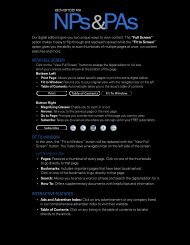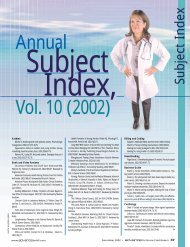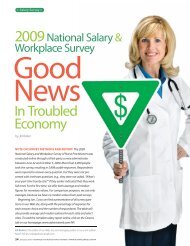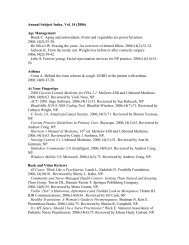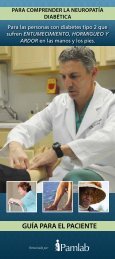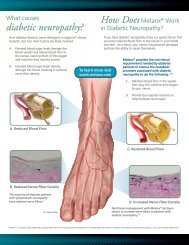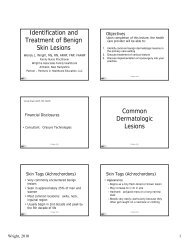View Full Screen - ADVANCE for NPs & PAs
View Full Screen - ADVANCE for NPs & PAs
View Full Screen - ADVANCE for NPs & PAs
You also want an ePaper? Increase the reach of your titles
YUMPU automatically turns print PDFs into web optimized ePapers that Google loves.
Pediatrics<br />
John Ciuppa<br />
➼ Between 6 million and 12<br />
million infestations of head lice occur<br />
every year in the United States. 1 Children<br />
between the ages of 3 and 11 are the most<br />
often affected, with occurrence more<br />
frequently in girls. 1<br />
Although head lice pose no public<br />
health threat or transmission of disease,<br />
they are an expensive nuisance.<br />
Treatments, lost wages and school<br />
expenses total an estimated $1 billion<br />
annually — an amount almost three<br />
times the estimated expenditure in the<br />
1990s. 2 The direct and indirect costs of<br />
treatment could be reduced by ending<br />
the “no-nit” policies en<strong>for</strong>ced by most<br />
school systems and by delivering efficacious<br />
treatments.<br />
Current Issues<br />
Pediculus humanus capitus is a six-legged<br />
parasite that grows no larger than 2 mm<br />
or 3 mm. Each leg has claws that allow<br />
the organism to grasp a hair follicle. Head<br />
lice survive by feeding off human blood<br />
every 3 to 6 hours. In optimal conditions,<br />
adult lice can survive more than 3<br />
weeks. Pruritus of the scalp is the most<br />
common symptom of an infestation, a<br />
result of localized allergic reaction to<br />
the louse bites. An infestation may be<br />
present <strong>for</strong> 6 weeks be<strong>for</strong>e symptoms<br />
become evident. The female lice<br />
lay eggs, or nits, within ¼ inch<br />
of the scalp. These hatch in 5<br />
to 10 days. The adult stage<br />
is reached about 10 days<br />
after hatching. 1,3<br />
Head lice infestation<br />
has historically<br />
been associated<br />
with lack of personal<br />
hygiene, lack of cleanliness<br />
in the home environment<br />
and (erroneously) lower<br />
The direct and indirect<br />
costs of treatment could<br />
be reduced by ending the<br />
“no-nit” policies en<strong>for</strong>ced<br />
by most school systems<br />
and by delivering<br />
efficacious treatments.<br />
socioeconomic status. The truth is that<br />
head lice infestations affect 5% to 10%<br />
of school-age children across all facets<br />
of life; rates of infestations among black<br />
children are lower. 1,2<br />
Head lice are most commonly transmitted<br />
through direct contact with the hair<br />
of an infected person. Environments in<br />
which direct contact often occurs include<br />
school, home, sporting practices/events,<br />
camps and slumber parties. Although<br />
parents and schools have long recommended<br />
that children avoid sharing hats,<br />
scarves, coats, combs, brushes and bed<br />
linens to prevent head lice spread, these<br />
are uncommon <strong>for</strong>ms of transmission. 1,2<br />
In an attempt to curtail the transmission<br />
of head lice, the National Pediculosis<br />
Association advocates a “no nit” policy: 4<br />
screening children <strong>for</strong> head lice to identify<br />
any evidence of lice or nits and immediately<br />
removing students with nits or<br />
lice from class until a re-examination<br />
proves clearance.<br />
Given the $1 billion burden associated<br />
with treating head lice and missing school<br />
and work, is this the best policy The<br />
American Academy of Pediatrics, the<br />
National Association of School Nurses<br />
and the Centers <strong>for</strong> Disease Control and<br />
Prevention recommend that children<br />
return to class as soon as treatment has<br />
been provided. 1,2,4 The CDC goes a step<br />
Kara L. Caruthers is an assistant professor in the physician assistant program at the University<br />
of Alabama at Birmingham and works clinically in emergency medicine. Patricia R. Jennings<br />
is director of the physician assistant program at the University of Alabama at Birmingham and<br />
also serves as a professor. She works clinically in the Division of Infectious Diseases at the<br />
University of Alabama Medical Center and the Birmingham Veterans Affairs Medical Center. The<br />
authors have completed disclosure statements and report no relationships related to this article.<br />
further by stating that children should not<br />
be immediately dismissed from school after<br />
a positive lice finding; instead, they should<br />
be allowed to complete the school day. 1<br />
Head lice do not fly, hop or jump. They<br />
crawl through the head, staying close to<br />
the scalp <strong>for</strong> both warmth and access<br />
to their food source (blood). They usually<br />
do not survive longer than 48 hours<br />
when away from the host. 1,3 Nits cannot<br />
hatch and usually die within 7 days if<br />
the temperature is not comparable to<br />
that of the scalp. 1 These facts support<br />
recommendations <strong>for</strong> discontinuing nonit<br />
policies. The cost of unnecessary<br />
absenteeism exceeds the risks associated<br />
with head lice.<br />
Permethrin<br />
The longstanding pharmacologic treatment<br />
of choice <strong>for</strong> head lice infestation<br />
is permethrin 1% lotion. 5 Permethrin<br />
(Nix) is a pediculicide that has reported<br />
secondary ovicidal properties. It is indicated<br />
<strong>for</strong> patients older than 2 months.<br />
Permethrin lotion was introduced in 1986<br />
and has been available over the counter<br />
since 1990. 2 It is associated with low<br />
levels of toxicity. 2<br />
Be<strong>for</strong>e using permethrin, hair must be<br />
washed with a nonconditioning shampoo<br />
and towel dried. A sufficient amount of<br />
lotion must be applied to saturate the<br />
hair and scalp; it should be rinsed off<br />
after 10 minutes. Current labeling <strong>for</strong> the<br />
product recommends a routine second<br />
treatment 7 to 10 days later. 2<br />
In recent years, reports of treatment<br />
failure with this therapy have surfaced<br />
throughout the world. Experts initially<br />
believed that the treatment failures were<br />
due to user error (nonadherence or failure<br />
to properly comb out nits), but in the<br />
United States, treatment failure is mostly<br />
attributed to increased resistance as a<br />
result of overuse and <strong>for</strong>mula changes. 4,6<br />
Malathion<br />
Malathion 0.5% (Ovide), an organophosphate,<br />
is a prescription pediculicide with<br />
ovicidal properties. It is available in a<br />
lotion or gel, and studies show it is more<br />
<strong>ADVANCE</strong> <strong>for</strong> NP & <strong>PAs</strong><br />
13



